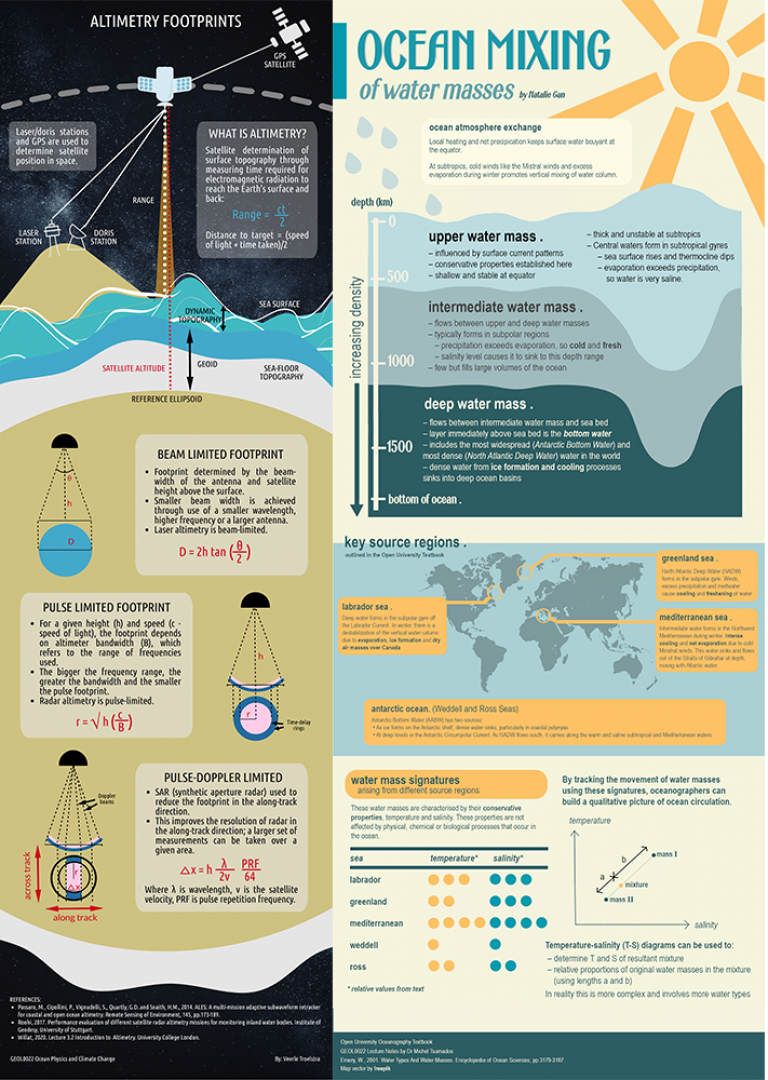Flipped Classroom ideas for Ocean Physics & Climate Change module #GEOL0022
10 December 2021
Inspired by the digital technologies lecture I've attended at UCL I ask students every week to present a brief summary of the previous lecture with the digital tool of their choice like infographics or video recordings.

Caption: The infographics by Verlee Troelstra and Natalie Gan.
I was appointed as a lecturer at UCL in April 2015 and soon after I had the opportunity to create a new module for our Earth Sciences 3rd year undergraduate program. The module - Ocean Physics and Climate Change (GEOL0022) 1 - reflects many of my research interests and therefore lends itself very well to the Connected Curriculum approach promoted by UCL.
GEOL022 is an optional 3rd year module in Earth Sciences and I have had a growing number of students (now more than 30) from all our undergraduate streams but also from physics, Natural Sciences, Geography and even Arts & Sciences.
The main learning outcome of the module is for the students to approach scientific problems with a “physicist’s” mindset – i.e. to learn how to simplify and formalize the natural climate processes to their simplest mathematical form. I am following a traditional – teacher centric – “lecture method” 2 of teaching alternating between derivations on the blackboard with illustrations on Powerpoint. I have enhanced my course with a rich online content of pre-recorded lectures, quizzes, practicals etc compatible with hybrid teaching during Covid but this traditional teaching mode has recently received criticism3 for (i) its one-way nature, (ii) the fact that students play a passive role and (iii) the strong expectations put on the speaker.
Inspired by the Arena 2 lecture on digital technologies4 I have tested a new activity that explores parts of the “flipped classroom” teaching methods5,6. I ask students every week to present a brief summary of the previous lecture with the digital tool of their choice6 and each infographics or video recording are formally assessed (~15%).
Caption: Waves: a look into the Arctic Ocean by Gillian Cheong
I showcase the best presentations at the start of every class and also online on @Twitter and @LinkedIn using the #GEOL0022 hashtag.
Caption: Thermohaline Cirulation, a singing contribution from Alessandra Quigley.
These have been very popular with the students who often produced high quality presentations and together will constitute a very useful database of teaching resources (i.e. for outreach and connected curriculum7) on how our changing climate is coupled with the changing ocean circulation.
References:
- GEOL0022 Ocean Physics and Climate Change
- blog.udemy.com/lecture-method/
- Jones, Leo. (2007). The Student-Centered Classroom. Cambridge University Press.
- Arena 2 course on the use of digital technologies by Nataša Perović Ballantyne et al. (2013). The flipped classroom: A survey of the research. ASEE National Conference Proceedings, Atlanta, GA. Vol. 30. No. 9. 2013
- Roehl et al. (2013). The flipped classroom: An opportunity to engage millennial students through active learning." Journal of Family and Consumer Sciences 105.2 (2013): 44.
- Enhanced E-Learning ideas.
- Connected Curriculum: a framework for research-based education
Links:
- Dr Michel Tsamado's academic profile
- Study the Earth
- "Are we waking up the sleeping Arctic Ocean?" - Dr Michael Tsamados
 Close
Close

